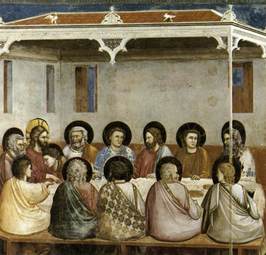 Honestly, I am not sure which is worse, to suffer oneself or to witness the suffering of another. For many of us, we would rather be the one suffering than to experience that feeling of utter helplessness as we watch a loved one, or even strangers, go through something terrible. To know there are people in dire situations is bad enough, but to know a friend or family member is suffering an illness or painful circumstance and to not be able to do anything to alleviate it, is often far worse than being the one in the crucible, so to speak. When we know others are suffering, or when we are upset by appalling situations in the world which are out of our control, it can be agonizing indeed. This is why we might cry out to the Lord: “This experience is hard: who can accept it?” For the past five weeks the Sunday Gospel has been from the sixth chapter of John, a section which is often referred to as the Bread of Life discourse. In it, Jesus is preaching to His disciples, describing how He is the Bread of Life of which we need to eat. I think this Sunday’s final installment of the discourse is in some ways the most challenging because it taps into the frustration which we can experience when life gets overwhelming. In this passage many of the disciples were murmuring with discontent, mystified over what Jesus had said about being the bread of life. They said, “This saying is hard: who can accept it?” (John 6:60) When Jesus responded, many of them left and “returned to their former way of life.” It was not that they simply left the locale where Jesus was speaking; they left His gospel way of life completely. They could not tolerate having to accept something that was beyond their understanding. So rather than try to stretch, allowing the words to take root within them, they took the ‘easier’ route, abandoning Jesus altogether.  Jesus was not just speaking about His body and blood. He was offering something eternal, which meant they had to accept that which came with it. It meant that His followers had to accept everything He taught, not just the parts which they liked, or the parts which were easier to do. If they wanted the way to eternal life, they needed to completely embrace Him and the values He taught. This is true for us, too. We need to embrace all that He taught, including that which we do not understand and that which is difficult, trusting that the Lord is with us and that we will indeed have eternal life through Him. It means accepting that Jesus entered fully into our lives and so we are called to enter fully into the lives of others, embracing not just the easy parts, but also the messier, more difficult parts. It means we rely on our faith. I think this ‘entering fully into our lives’ which Jesus did is what compelled St. Rose of Lima, (whose feast day is August 23), to a life of serving the suffering. If we only take a brief glance at her life, we might be tempted to dismiss her because of her choices. As a young woman of the late 16th century, she worked hard to support her poor parents, who, because Rose was very beautiful, wanted her to marry, possibly to have greater financial security. However, Rose wanted to follow in the footsteps of St. Catherine of Siena, and in so doing chose to become a Dominican tertiary, (a laywoman who takes vows to live in the lifestyle and spirituality of the Dominicans.) Therefore, in order to ward off suitors, she disfigured herself by rubbing her hands and face with pepper, and if that is not strange enough, she practiced all sorts of bodily mortifications which we would think of as insane. To put it bluntly, she made herself suffer constantly. She died at 31, quite possibly from all of the strange practices she took on. Why on earth would anyone want to do that? Furthermore, why would we think someone like this is a saint?  As I indicted earlier, if we only look at the seemingly strange behaviors of Rose, we will miss why she is considered so holy. She spent hours in prayer, which moved her outward to the destitute, homeless, and ill. She often brought them into her own room to care for them with great kindness and tenderness. Therefore she was surrounded daily by those who were suffering. But many of those who knew her thought she was crazy. Her way of life brought her sickness, ridicule, and even a visit from the Inquisitors. She sometimes did struggle and was said to have bouts of terrible sadness and loneliness. Perhaps there were times when she cried out, “This is hard: who can accept it?” But she did remain faithful to her ministry until her early death. Though her mortifications were horrific and nothing anyone should ever really do, it may have been that she wanted to suffer as a way of being in solidarity with those all over the city who had no control over their own suffering. Whatever it was, she brought much healing and goodness into the lives of those she served. And in doing so, she brought them to the Lord. Through her prayer and desire to express her love for Jesus, St. Rose was dedicated to offering her life in a very dramatic way. She opted to live the hard sayings of Jesus instead of taking the easier road or simply worrying about herself. Rather than trying to understand the way Jesus chose for Himself or to explain it intellectually, she chose to wrestle with the incomprehensibility of suffering by suffering herself. It was her way of reaching out to those who were desperate for help, those who simply needed someone to enter into their suffering with them so that they were less alone. This is truly what mercy and compassion are about. The compassionate, like Jesus, suffer with the suffering and share joy with those rejoicing.  We should not make ourselves suffer as she did. Life will bring suffering of its own, unbidden. At some time or another we will all feel helpless to stop the pain of a loved one or be frustrated when we see the evil in the world, knowing we cannot change the way things are. But what we can learn from St. Rose of Lima is that our interior suffering, as well as our own physical suffering, can be offered as prayer. It stretches our hearts to greater compassion. It helps us to realize that we can pray for others, that we can move outward in service, and that we can be a presence to those who need us. Our efforts will not take away the suffering of the other, but the love which motivates us to be present to them, or to serve them, does have significance. It makes a huge difference to the suffering ones to know they are not alone or forgotten. What may feel like paltry efforts on our part are enormous gifts to those who are suffering. But the one thing we have to embrace, as did Rose, is that we cannot understand it. Unlike the disciples who abandoned Jesus, we must let faith, hope, and love be the ‘glue’ which enables us to stay in the midst of that which is hard. We will never know what drove St. Rose of Lima to go to the lengths she did. Maybe she felt her mortifications were necessary to keep her focused on the suffering of others, so that the frustration of witnessing their suffering did not overwhelm her. Maybe it was a way of letting them know that she understood what they were undergoing. But what is clear is that she knew that the only way to do this was to turn to the Lord, who is the Bread of Life, and cling tightly. Our mortification is not to make ourselves suffer, but to accept the difficult challenges which have been put before us. Simply living a Christian lifestyle in today’s world is difficult enough. To accept that our small efforts count for something, to live morally, to stand up against injustice, to forgive the one who has hurt us, to go on when life beats us down, to love those who are unlike us or who say they are our enemies, to offer a hand to a stranger; these are all difficult mortifications when it would be easier to ‘look the other way.’ Let us be like St. Rose, and also like the apostles who when Jesus asked if they too wanted to leave, said, “Lord, to whom shall we go? You have the words of eternal life.”  May we have the courage to accept the hard sayings of Jesus and stay with Him as a true disciple! May we be like St. Rose of Lima, accepting the difficult work of living the Christian life despite our critics and enemies! May we ask for the intercession of St. Rose, that her prayers may inspire us to respond to the call of Jesus! May we not be intimidated by suffering or the enormity of need in the world! May we have the peace and the strength to live the gospel, so that we may bring joy to those who suffer greatly! And may our hearts be stretched by our experiences, so that we may be people of compassion and mercy! Let us continue to meet in the heart of Jesus! Peace! ©Michele L. Catanese For more information on the life of St. Rose of Lima there are many sources available. Some suggestions are: https://en.wikipedia.org/wiki/Rose_of_Lima http://www.americancatholic.org/Features/Saints/saint.aspx?id=1116 http://www.catholic.org/saints/saint.php?saint_id=446 The first painting is the work of Giotto, (1300-05) and it is called Last Supper and is in the Arena Chapel in Padua, Italy. The next is a photo which I took while hiking on Copper Mountain in Colorado. There really is no easy road. We still had quite a hike. Next is a beautiful icon painted by Fr. William Hart McNichols called Santa Rosa Patroness of The Americas. It can be found at http://fineartamerica.com/featured/santa-rosa-patroness-of-the-americas-166-william-hart-mcnichols.html The following photos are also mine. The first is of a rose, taken in Portland, Oregon. The second is a waterfall, taken in the Black Hills of South Dakota. Comments are closed.
|
Heart Speaks to Heart
|

 RSS Feed
RSS Feed

